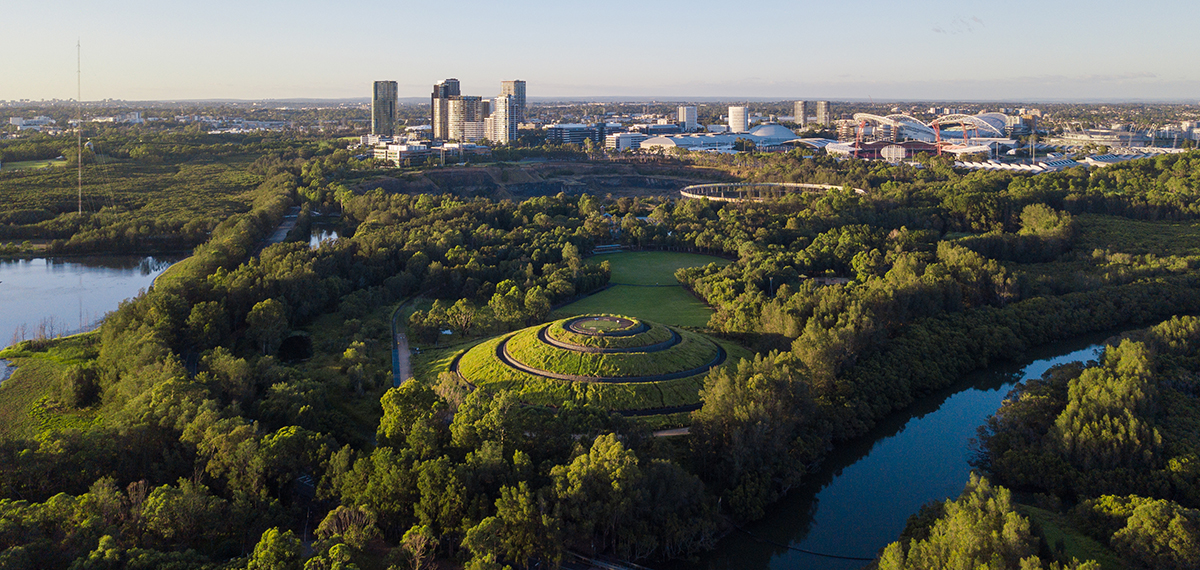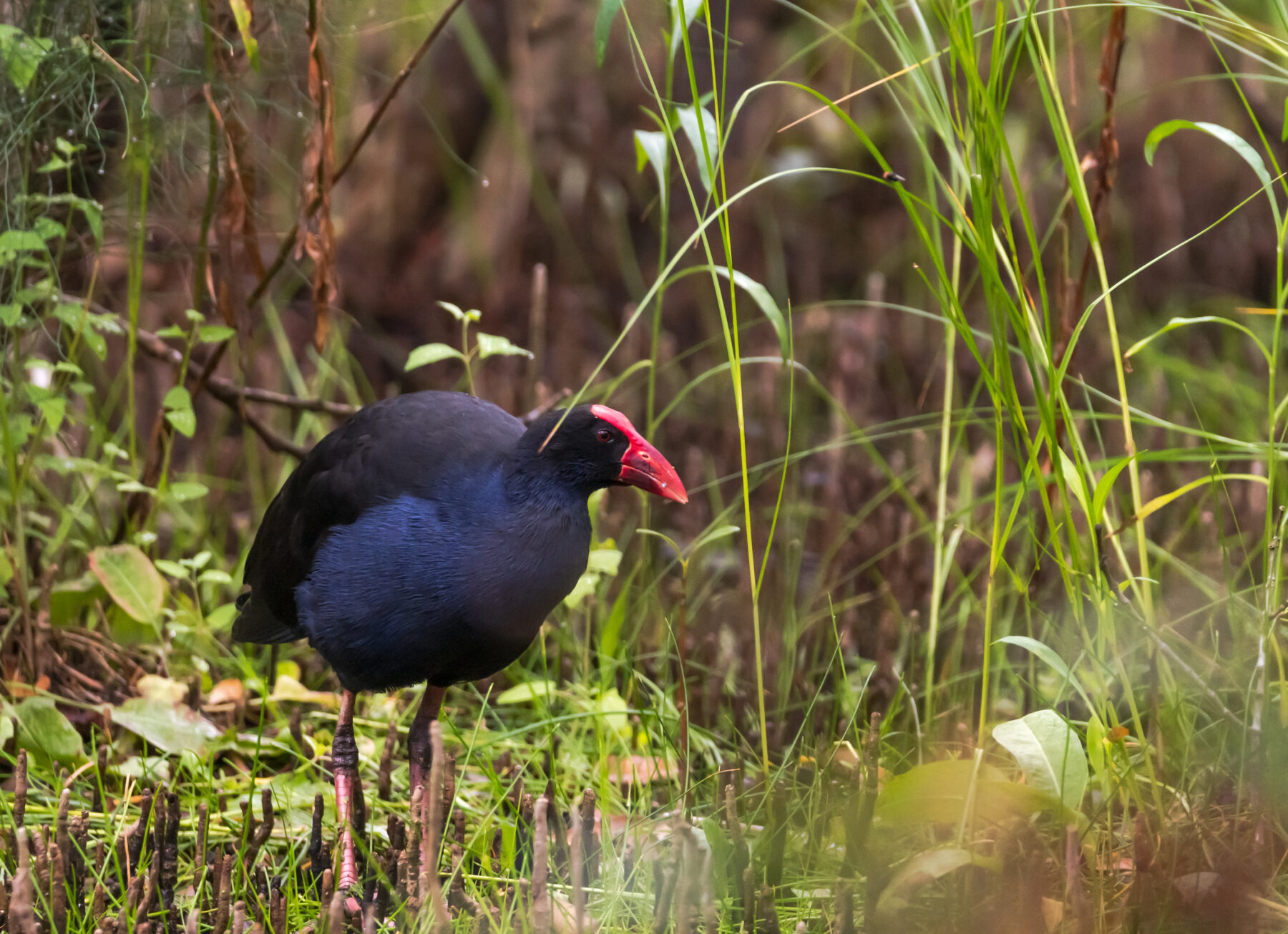Urban birdwatching guide to Sydney

As our cities have become greener in recent decades, the wildlife has returned. According to biologist Tim Low, more than 50 new bird species have been recorded in Sydney since 1958, with 15 of those making a permanent home here.
The best place to start for beginners to spot some or all of these avian Sydney-siders is the easily accessible Centennial Parklands.
“The birds at Centennial Parklands are generally approachable,” says Allan Richards from Birding NSW. “Most of the ponds are excellent for waterbirds. Areas of bush at Lachlan Swamp and around Kensington Ponds are good for bush birds including the superb fairy-wren. There are often local bird watchers in the park who are willing to assist visitors.”
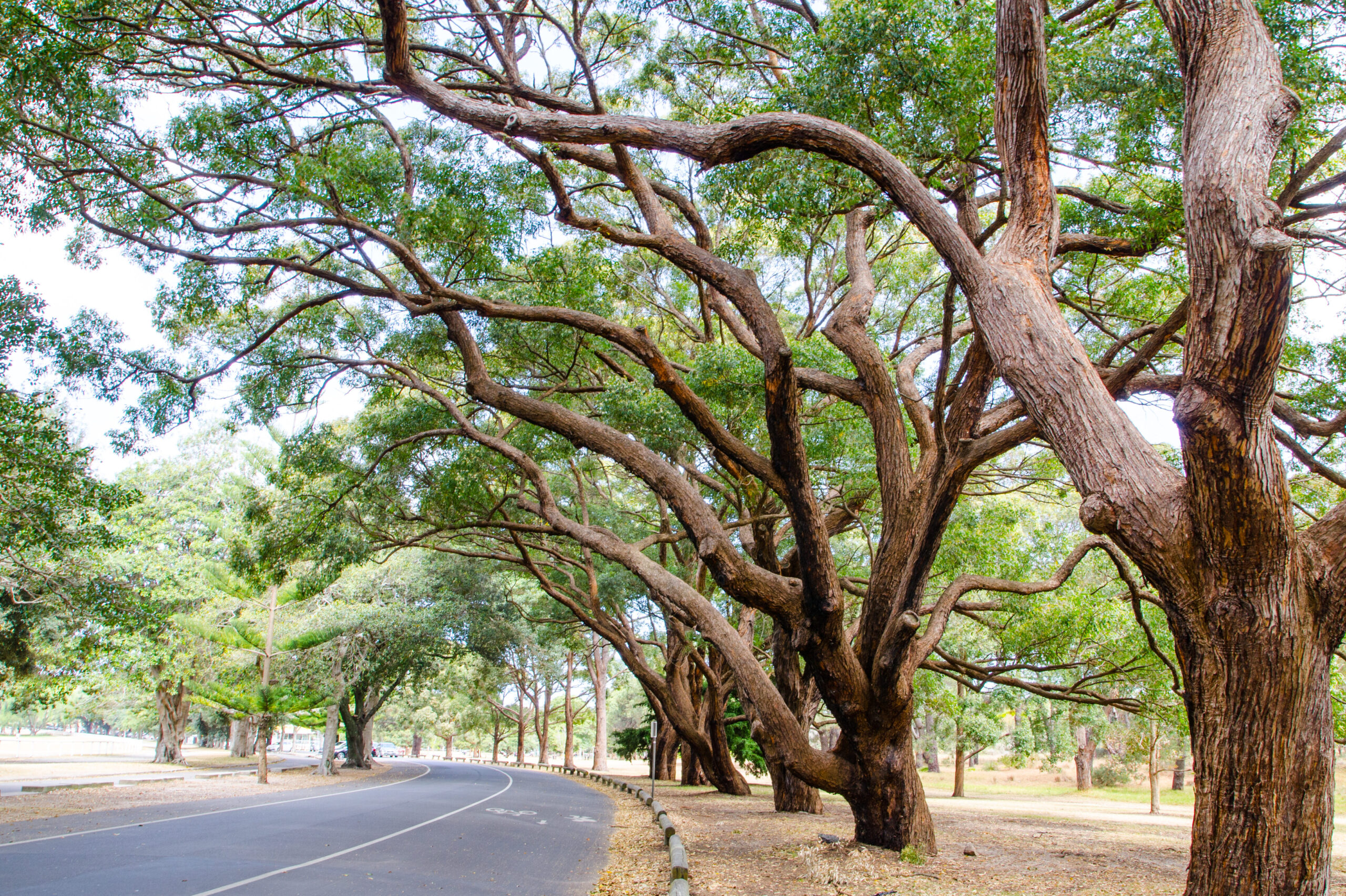
Sydney’s iconic harbour and coastline support all sorts of seabirds, and more than 200 native bird species have been spotted at Sydney Olympic Park.
“Sydney Olympic Park mainly attracts waterbirds,” says Allan. “The best areas for birds are the waterbird refuge, Badu Mangroves, Lake Belvedere, The Brickpit, Wentworth Common and Haslams Pier.”
Other birding hotspots include the Royal Botanic Gardens and Warriewood Wetlands.
“At Warriewood, the swamp mahoganies flowering in winter attract many honeyeaters and lorikeets,” says Allan. “There are a number of brush turkey mounds and whipbirds are used to people so can be confiding.”
Birding outside the city
The Greater Sydney region is home to 49 national parks, many of these within easy reach of the CBD. At Royal National Park, more than 300 bird species have been recorded, while the Capertee Valley, about 40km north of Lithgow in the city’s north-west, is also one of the world’s top 50 birdwatching sites and a designated Important Bird Area. It’s also one of the last strongholds of the endangered regent honeyeater.
“There are excellent areas for birds in Royal National Park,” says Allan. “Wattle Forest and Lady Carrington Drive near Audley have a good range of birds including the lyrebird. The cliff-tops along the coastal track south of Wattamolla are usually a good spot to see the rockwarbler, the only endemic NSW species.”
We’ve put together a list of 20 Sydney bird species that might share your backyard:
Sydney bush birds
Look for these species in bush, trees and leafy suburbs:
Nankeen kestrel
Falco cenchroides
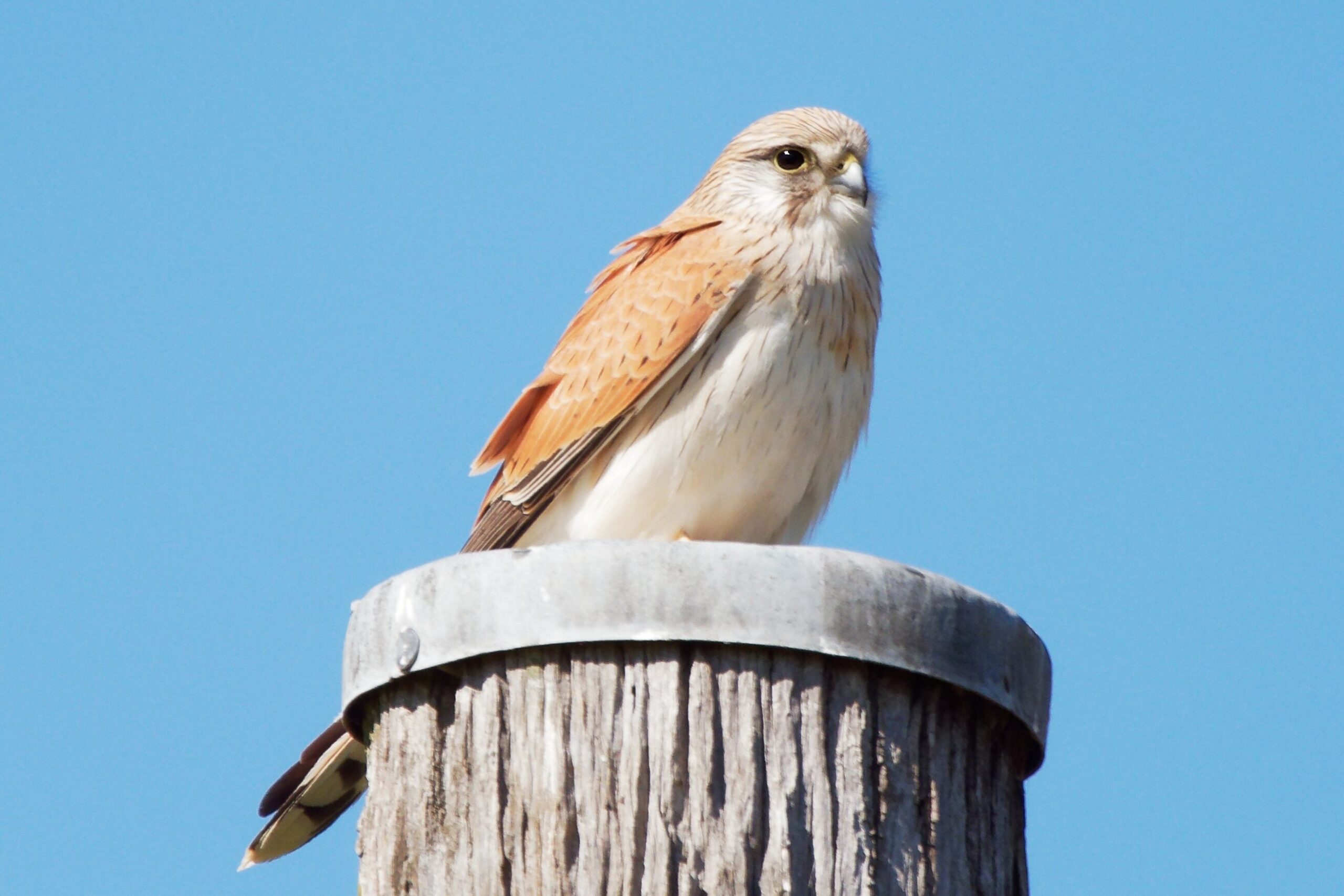
The nankeen kestrel is one of the top 10 most commonly seen birds across Australia, and its adaptability to a variety of food sources and nesting sites have made it a successful bird of prey.
It is a small raptor with rich, rufous colouring above, a black-tipped tail, and creamy underparts flecked with brown and black. They prefer open, sparsely vegetated areas including fields and grasslands.
Nankeen kestrels can be distinguished from other birds of prey by their small size, pale bellies, and tendency to hover in one spot. This motionless hovering behaviour allows them to spot their prey below, then lower down to pounce.
Size: 34cm
Call: Shrill ‘kekekekekeke”, high-pitched trembling scream.
Where to spot them: Sitting on powerlines, hovering over open pasture.
Red wattlebird
Anthochaera carunculata
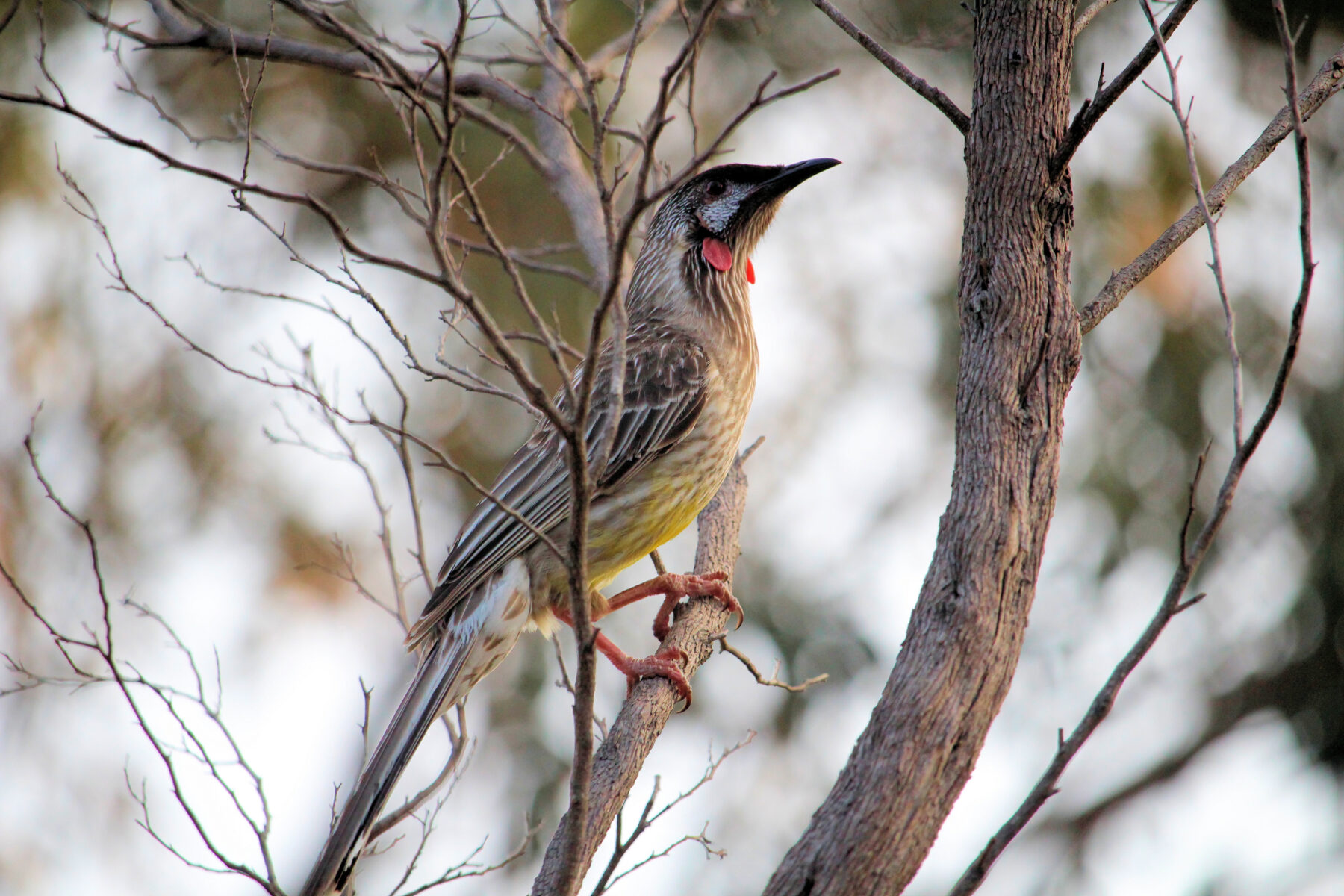
A large honeyeater species, wattlebirds feed by probing flowers with their curved bill and soaking up nectar with their special brush tongue. They have streaked white, grey and brown plumage with a yellow splotch on their belly and red wattles on their white cheeks. Wattlebirds are loud, flappy and can be aggressive towards other bird species.
Size: 35cm
Call: Harsh coughing ‘yak’ or ‘chok’.
Where to spot them: In treed gardens, woodlands and parks – especially near flowering bottlebrush species.
Eastern koel
Eudynamys orientalis
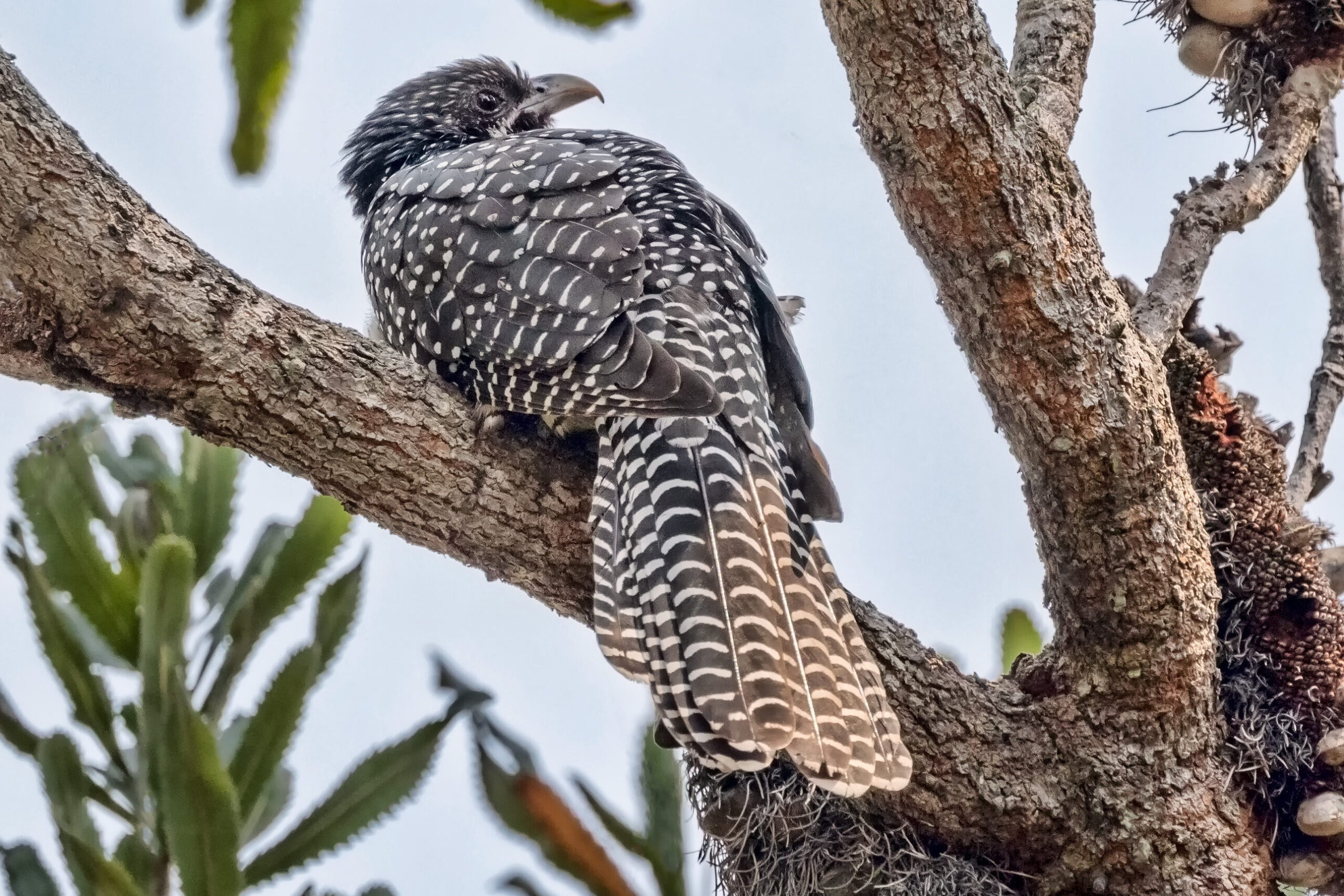
A shy bird, the call of the koel is a common sound during the summer months in Sydney. The male is a glossy black colour with a blue-green sheen and a piercing red eye. The female has a black crown, dark brown back speckled with white, and her underside is striped black and light tan/off-white. The juvenile is similar to the female, but has more tan coloration.
The koel is part of the cuckoo family, and like other cuckoo species, it lays its eggs in the nest of other birds, leaving them to raise its young. The eastern koel exploits the red wattlebird. As wattlebird numbers have increased in urban areas, so too have koels. Koel populations may also be increasing thanks to more fruit trees – they especially like figs.
Koels breed in Australia during the summer months, and then migrate north to New Guinea for winter.
Size: 42cm
Call: An incessant ‘kooo-el’.
Where to spot them: More likely to be heard than seen – but you may spot them feeding on fruit in the canopy.
Australian brush turkey
Alectura lathami
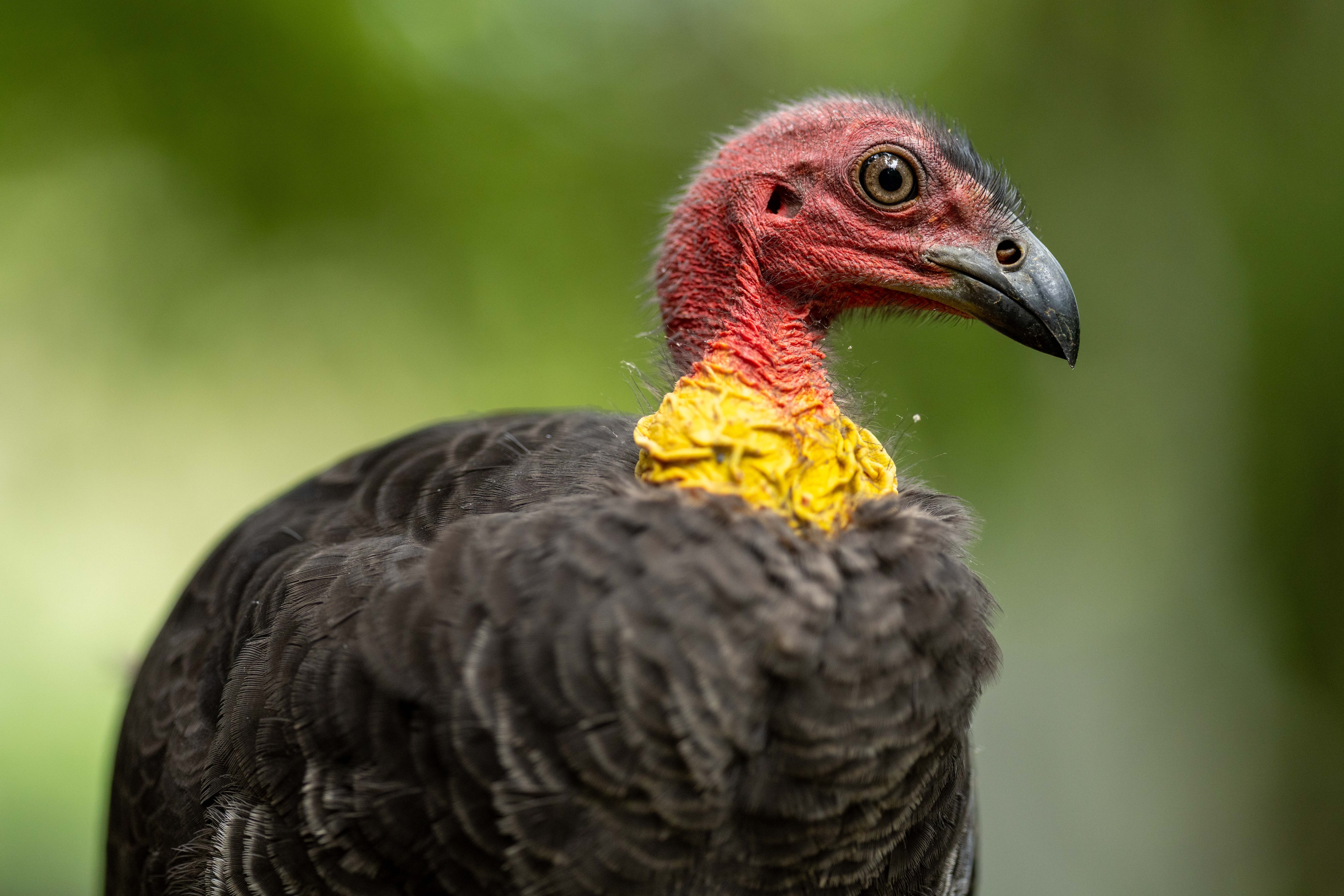
Brush turkeys, also known as bush or scrub turkeys, are yet another species that have adapted to modern city life. Easily recognisable by their bright red bald head, yellow throat dangler, black plumage and fanned-out tail, brush turkeys have invaded the bushy suburbs of northern Sydney.
They often scratch up gardens looking for food, and males build large compost heaps out of vegetation, up to four metres across. Brush turkeys build these mounds to incubate their eggs. The dad will stick his beak into the muck of leaves, dirt and twigs to check the temperature remains a cosy 35 degrees, and adjust the mound as necessary.
Size: 70cm
Call: Low grunting.
Where to spot them: Urban treed areas, bushy gardens.
Grey butcherbird
Cracticus torquatus
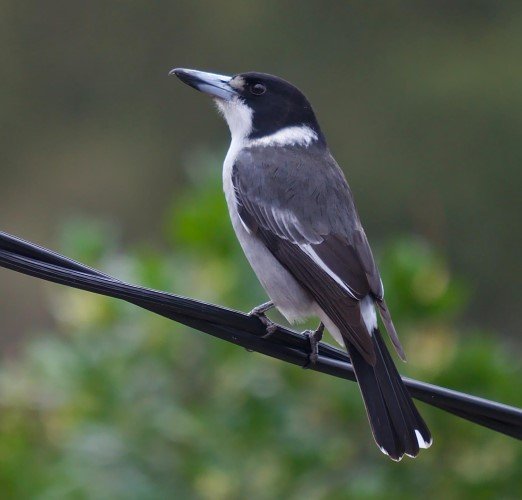
These feisty little birds are named for their habit of impaling prey on sticks, or hanging it in tree forks. Butcherbirds have a little hook in the end of their upper bill – perfect for grabbing prey such as small lizards, birds and insects.
They look vaguely like a small kingfisher, but have a black head, white underside, grey back and thin white collar. Juveniles have browner colouring.
Size: 27cm
Call: Enchanting musical call, interspersed with harsher notes.
Where to spot them: Sitting on an open perch, wooded habitats including suburbs.
Superb fairy-wren
Malurus cyaneus
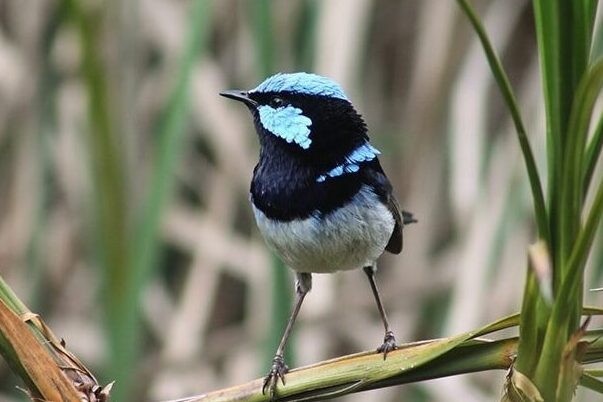
These tiny feather-spheres make up for their small size with bright colours – or at least, the males do. Male superb fairy-wrens don iridescent blue and black breeding plumage, while their tum is white-grey. Females and young birds are brown-grey all over.
Superb fairy-wrens are common in urban gardens and parks, as long as there is sufficiently dense, low shrubbery for shelter. They can be seen flitting in and out of bushes low to the ground, catching insects. They feed in small social groups, usually consisting of one male plus several females and young birds.
The mating habits of superb fairy-wrens are more scandalous than celebrity tabloid news: One female may be courted by up to 13 males in the space of half an hour, and three quarters of a female’s offspring will be fathered by males outside her social group.
Size: Small – 14 cm
Call: High-pitched trills.
Where to spot them: Darting in and out of low bushes in parks, gardens and forest.
Australasian figbird
Sphecotheres vieilloti
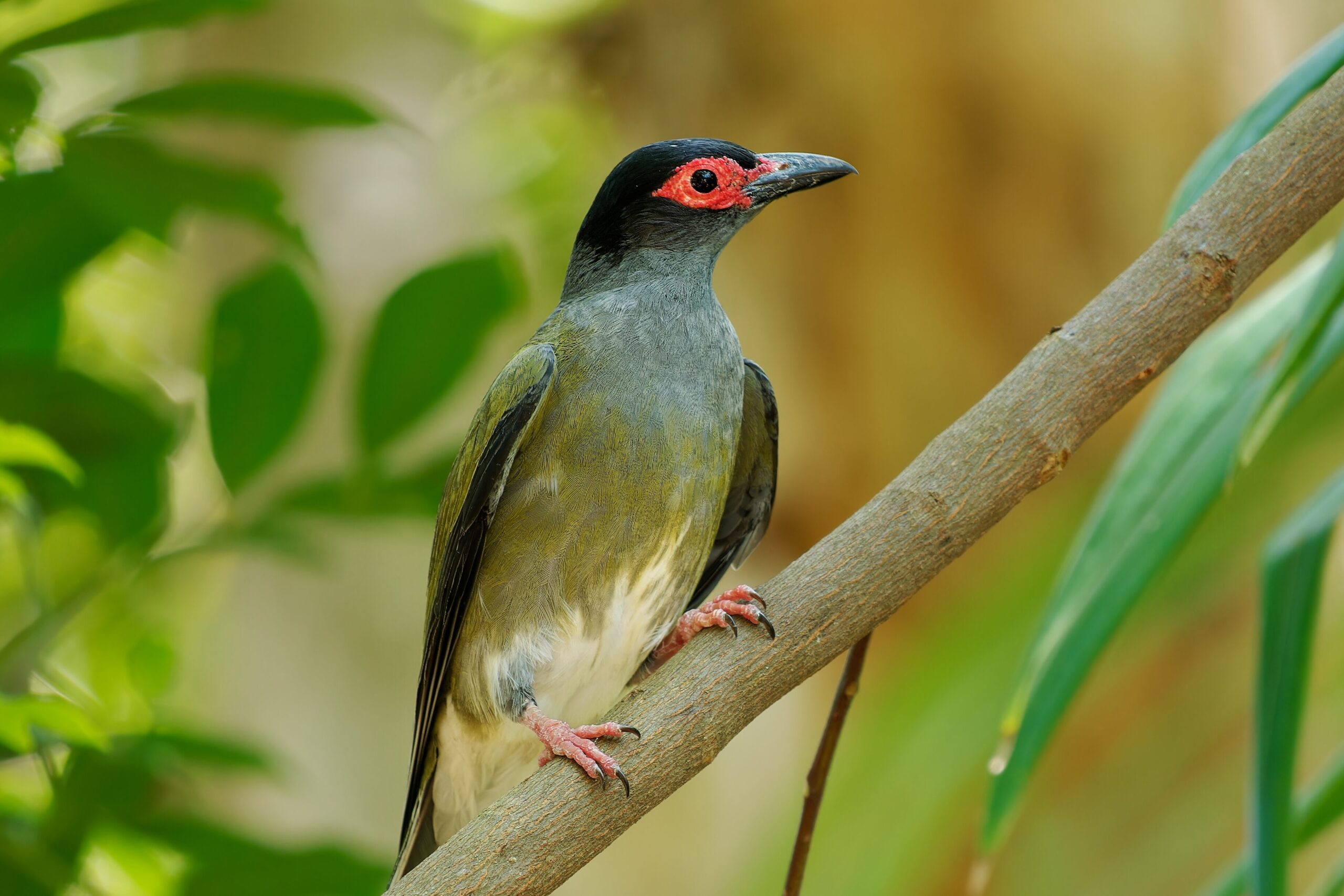
Figbirds are typically rainforest birds, but they have moved into parks and gardens where they devour the abundant fruit in flocks up to 20-strong.
Male figbirds in Sydney have a bare, red eye patch on their otherwise black face and crown. The black merges into grey along the throat and neck, and the remainder of the body is an olive green. The underside of the tail provides a flash of white.
Females, on the other hand, have an understated appearance. They have a grey bare-skin eye patch and mostly brown plumage, except for their underside which is off-white streaked with brown.
Size: Medium – 29cm
Call: Loud repeated ‘chiew’.
Where to spot them: Feeding on soft fruits (especially figs) in leafy trees of parks, gardens and orchards.
Eastern whipbird
Psophodes olivaceus
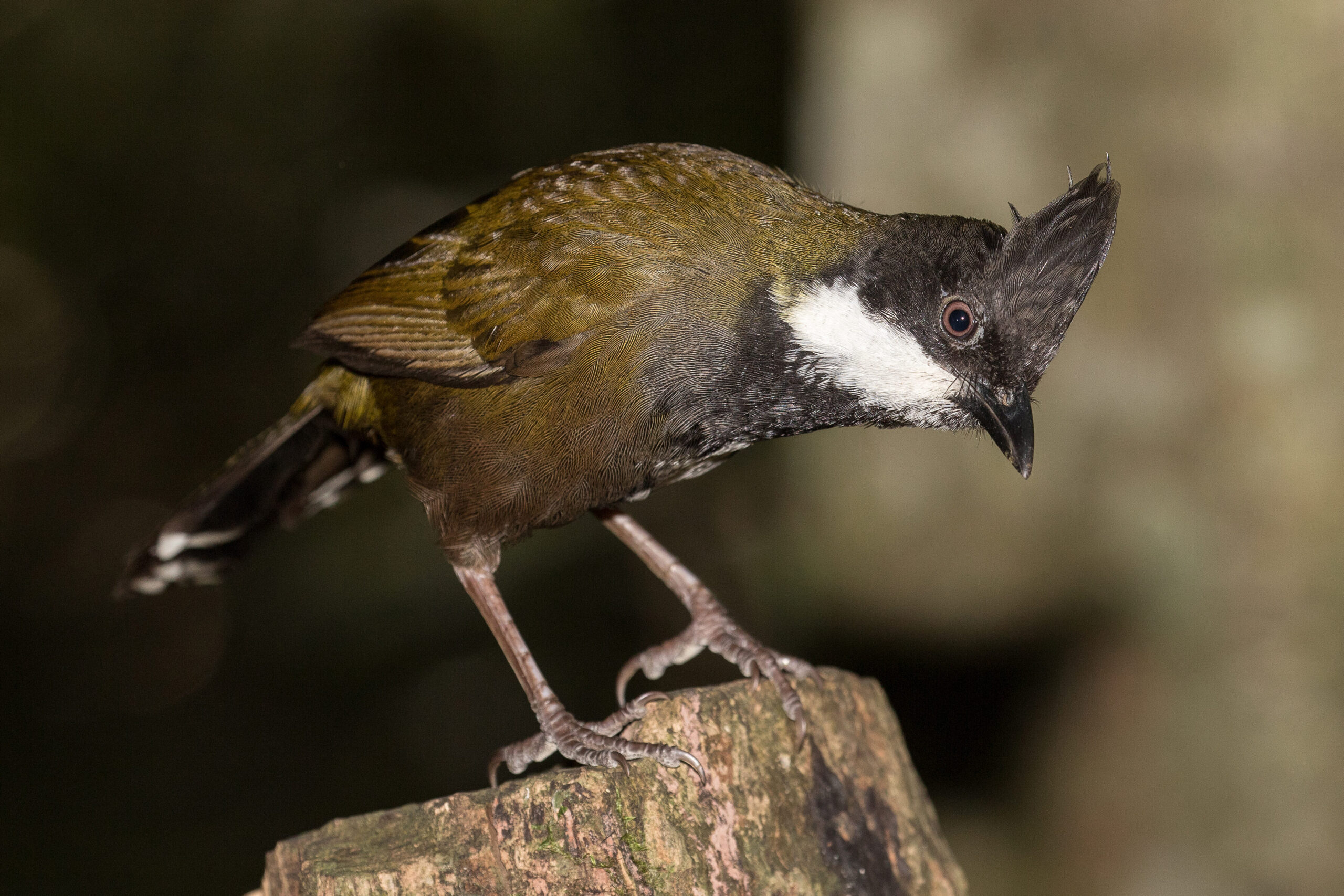
Whipbirds are decked out in olive green plumage, with a black head and breast, and white cheeks. They also sport a small spiky crest. Whipbirds are not often seen as they are secretive and spend most of their time foraging for insects on the leaf-littered forest floor. But if you’re patient, they can be curious and may come out to say hello.
They may be inconspicuous sight-wise, but their call is anything but. Their whip-crack call is unmistakable – and if you’re close by, on the verge of deafening. The male’s rising whip call is often immediately answered by the female’s ‘chiew chiew’.
Size: 28cm
Call: Rising loud whip-crack (male) followed by ‘chiew-chiew’ (female)
Where to spot them: In wet forests around Sydney, at Warriewood Wetlands.
Outer Sydney birdwatching
You may have to venture outside the city to see these special birds, but they’re still found within the Greater Sydney region.
Superb lyrebird
Menura novaehollandiae
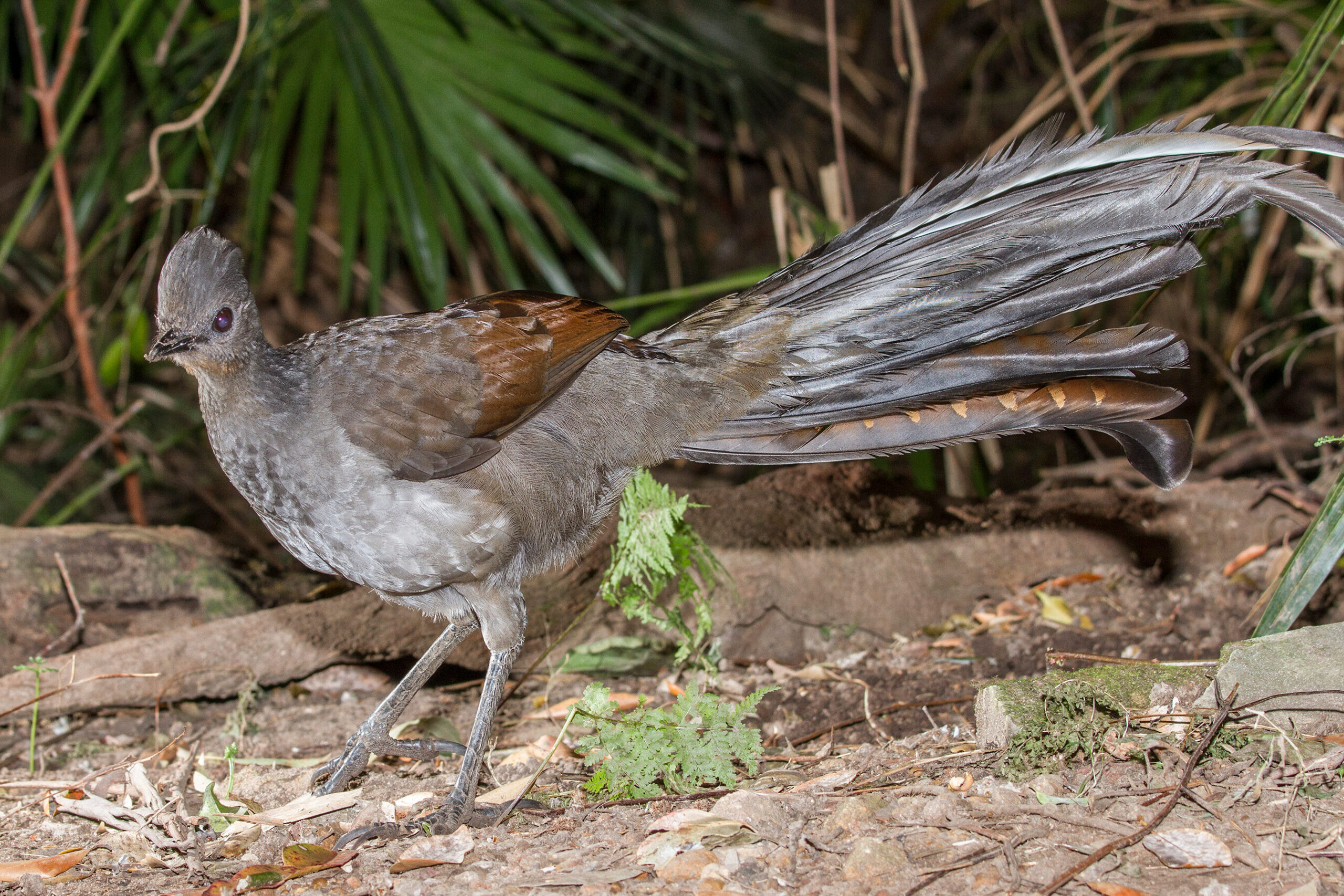
Majestic chooks of the forest, these ground-dwelling birds look somewhat like a large brown pheasant. If you’re walking through the bush, listen out for rustling and scratching – it could be a lyrebird digging through the leaf litter to find some tasty insects.
Or, you could be lucky enough to hear the lyrebird’s impressive vocal repertoire. The lyrebird is an expert at mimicry, and his song will incorporate all kinds of sounds: from local native birds, to dogs barking, to car engines. Males perform their mimicked medley with an accompanying shake of the tail feathers to attract the ladies.
Male superb lyrebirds have ornate tails with wispy grey and brown feathers blooming out of their rumps. They have rufous wings and grey-brown heads and underparts. Females lack such an elaborate plume, instead bearing a plain brown tail.
Size: 90cm
Call: An incredibly varied suite of mimicked sounds; series of whistles and cackles.
Where to spot them: In the forests of Sydney’s national parks.
Rockwarbler
Origma solitaria
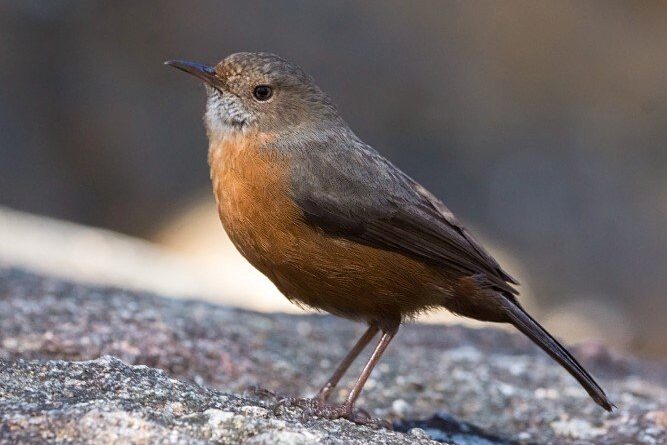
The only bird endemic to NSW, the rockwarbler makes its home on the sandstone formations and rocky outcrops around Sydney.
The rockwarbler is a small bird with a dark grey-brown back and wings, a pale grey throat and a rufous underside. It flicks its tail as it hops over rocks searching for insects to eat. Occasionally, rockwarblers will nest inside buildings.
Size: 14cm
Call: Raspy ‘chee-cheet’ squeaking.
Where to spot them: Rocky areas e.g. coastal cliffs, steep rocky gullies, outcrops within 240km of Sydney.
Regent honeyeater
Anthochaera phrygia
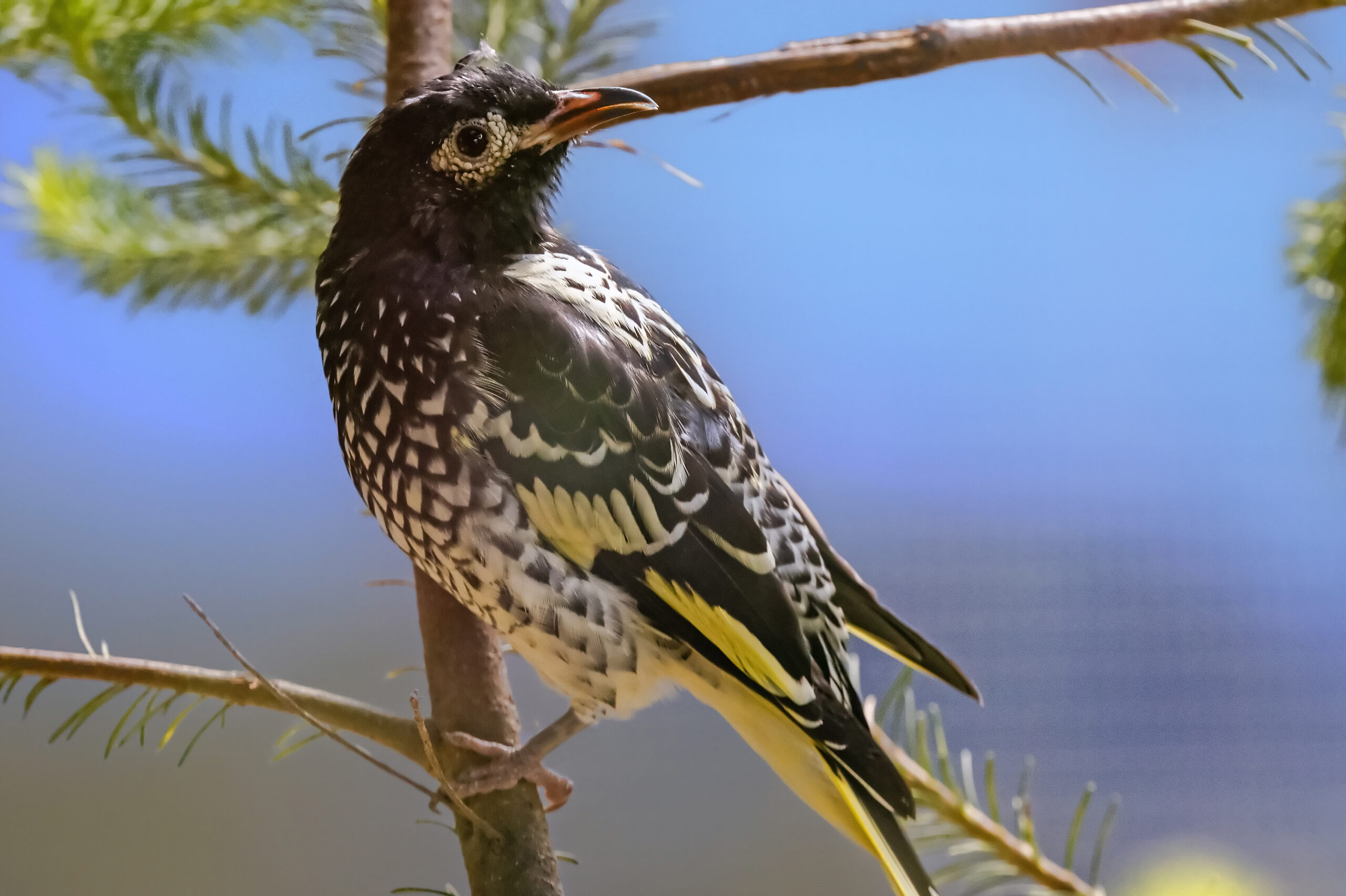
To see this critically endangered bird, you’ll probably have to venture out to Capertee National Park, the home of one the last major breeding flocks. But the trip will be worth it, as regent honeyeaters are stunning in their black and lemon-yellow plumage.
They have a black head and breast, a yellow and black speckled belly, black wings splashed with patches of yellow, a yellow back, white rump and a black tail edged with yellow. In males, the eye is surrounded by rough yellow bare skin.
Regent honeyeaters are sociable and hang out in flocks in box-ironbark forests, feeding on nectar, insects and fruit. They are nomadic and will travel considerable distances to feed on flowering trees.
Size: 22cm
Call: Soft melodious warbling – they bob their heads when they call.
Where to spot them: Capertee Valley, sometimes in swamp mahogany and spotted gum forests on the Central Coast.
Sydney city’s common birds
These species are common in Sydney and easily spotted within the city.
Australian white ibis
Threskiornis molucca
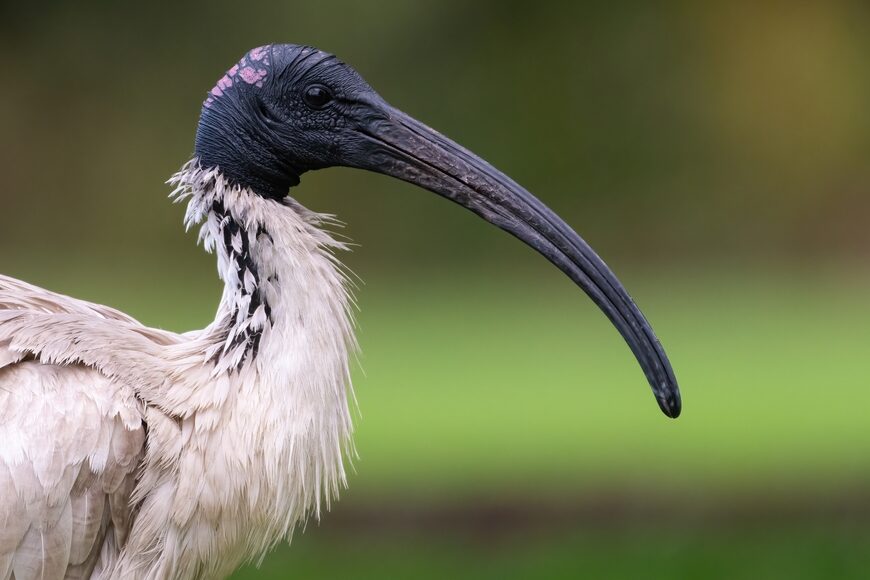
Sometimes referred to as ‘bin chickens’ or ‘trash turkeys’, these birds have found a new niche scavenging urban waste, along with a bad rep as pests. They have long legs, white feathers, and bald black heads with a long, curved beak. Adults have a fancy feathered ruff around the base of their neck.
Even though ibises are found in increasing numbers in our parks and gardens, populations across natural habitats (grasslands, wetlands, lagoons) are declining.
Size: 72cm (over knee-height)
Call: Croaks.
Where to spot them: Bins, urban parks, rubbish tips, lagoons.
Rainbow lorikeet
Trichoglossus haematodus
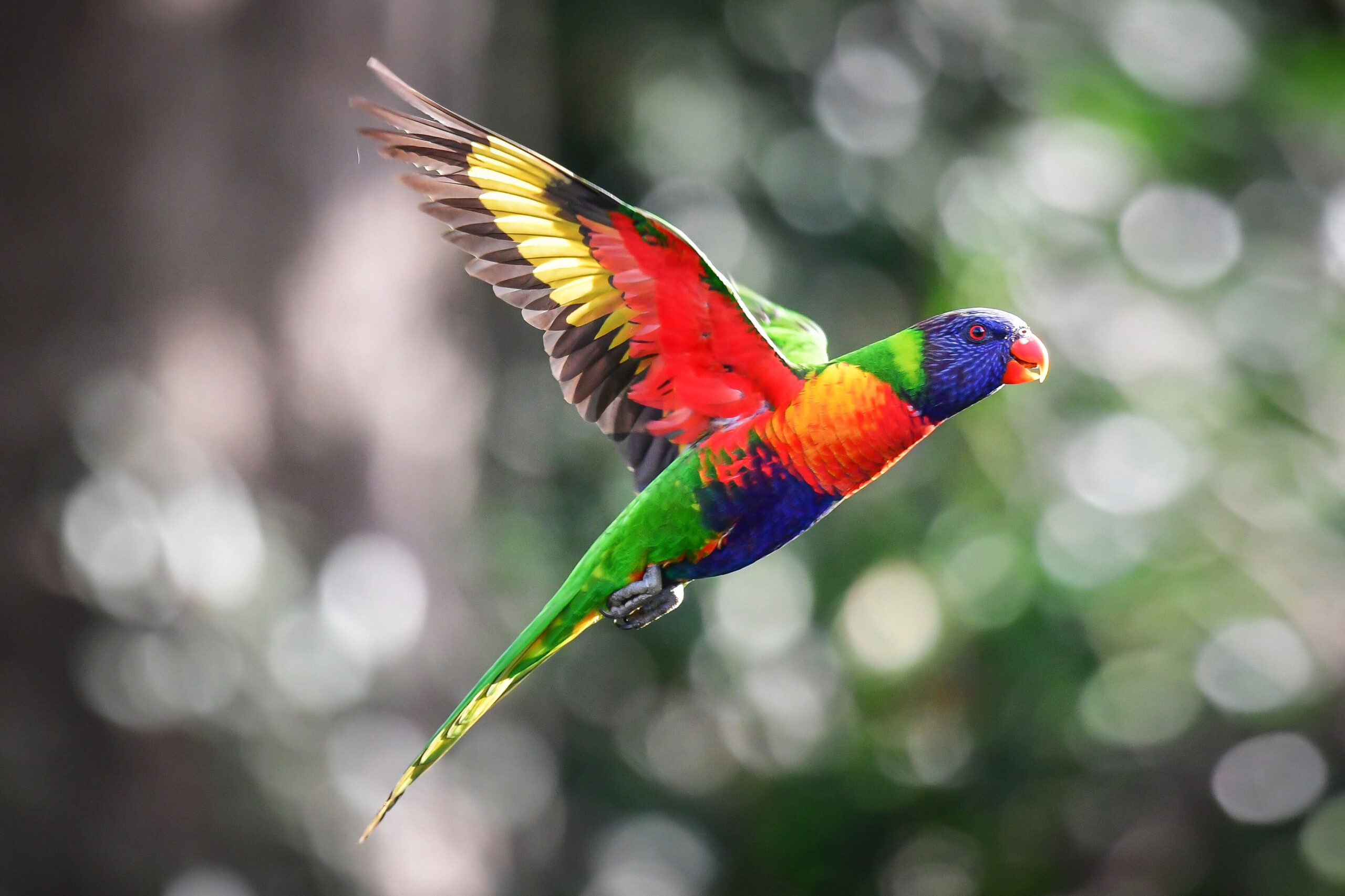
Rainbow lorikeets are hard to miss with their brightly-coloured garb and noisy chattering. They fly super-fast in tight squadrons and prefer the leafy surrounds of tree-filled suburbs, especially if plenty of tasty nectar or fruit is available. Rainbow lorikeets roost communally, so you can often hear them squabbling and telling cacophonous bedtime stories around sunset. These clowns have a blue head and tum, green back and wings, bright orange breast and red beak.
Size: 30cm
Call: Screeching, chattering.
Where to spot them: Suburbs and parks with tall trees, forests, around flowering or fruiting plants.
Sulphur-crested cockatoo
Cacatua galerita
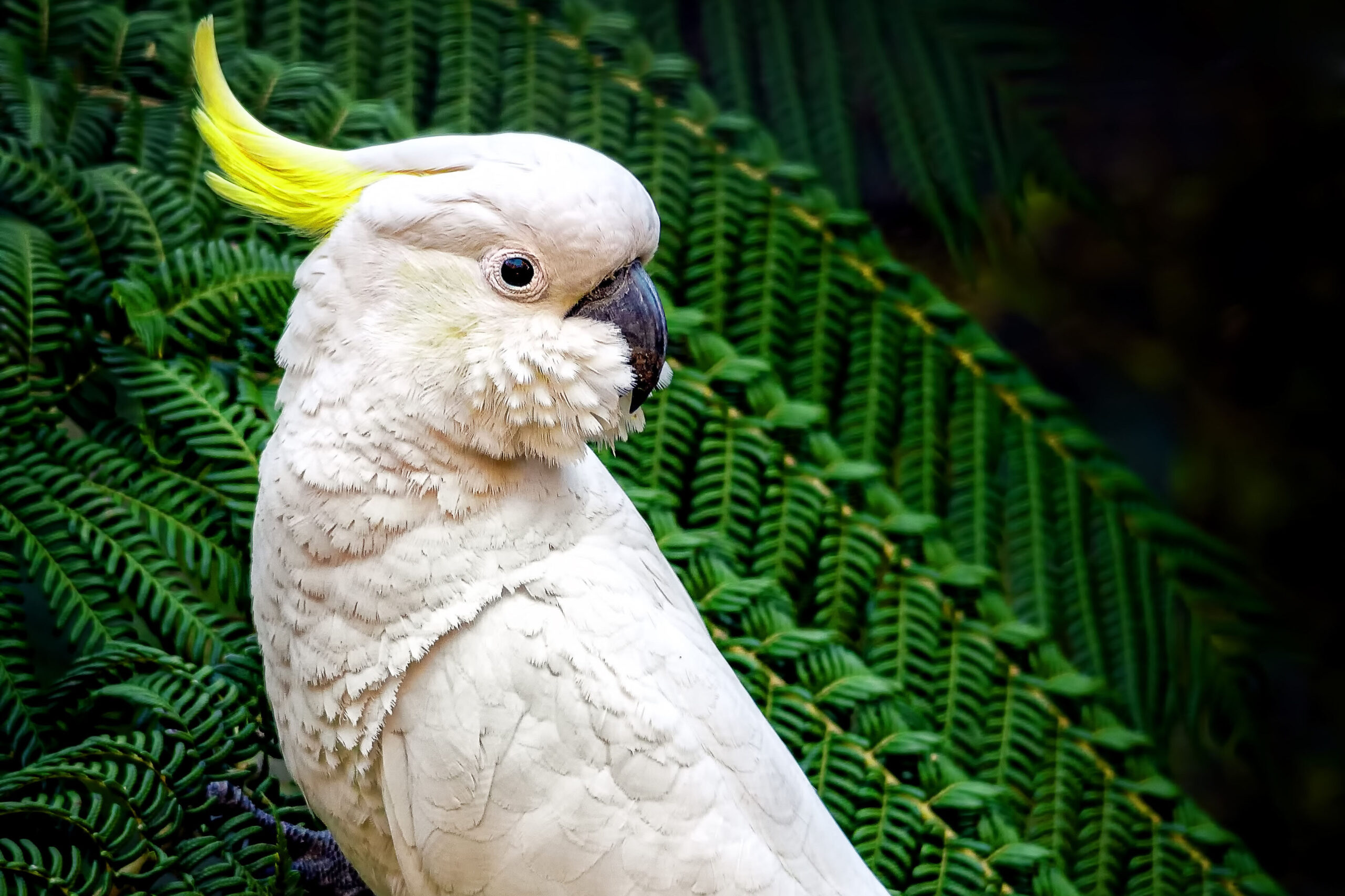
These raucous parrots can be heard screeching their lungs out – often when you’re trying to sleep in the morning. They are large and white with an impressive yellow, Mohawk-like crest. The undersides of their wings are also splashed with sulphur-yellow colouring.
Sulphur-crested cockatoos have adapted well to city life, and can sometimes be seen destroying light fixtures or timber panelling with their big, grey bill. Their curiosity, intelligence and striking appearance have made them an Australian icon.
You may notice some ‘cockies’ in Sydney with numbers pinned to their wings. These birds are part of the Wingtags research program, run by the University of Sydney, Royal Botanic Gardens & Domain Trust and Australian Museum. Make sure you log sightings of these fellas, each with a unique name, using the Wingtags app. The cockatoo pictured is called Heineken.
Size: 48cm
Call: Extremely loud screeching.
Where to spot them: Parks, gardens, forest.
Silver gull
Chroicocephalus novaehollandiae
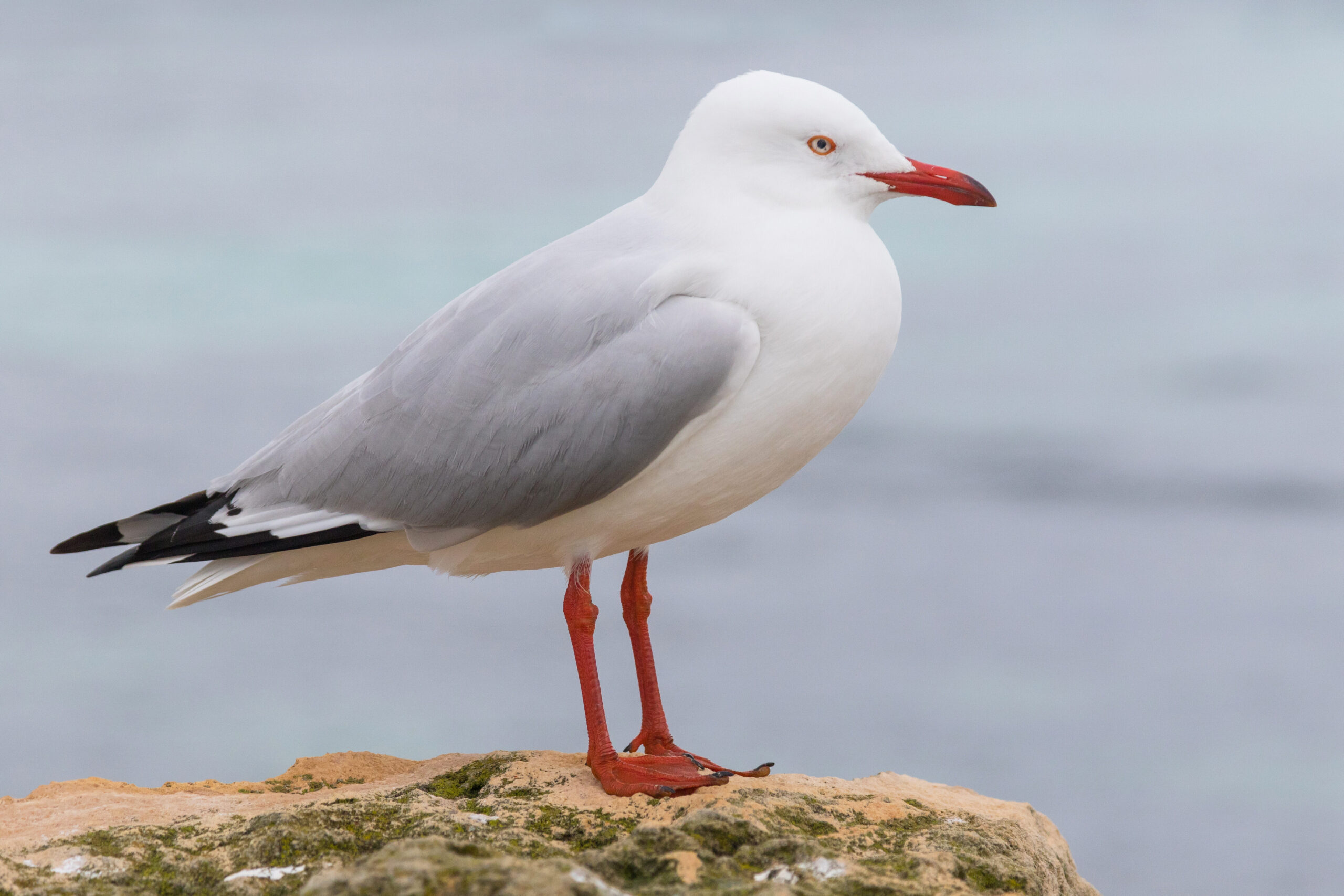
This species is easily distinguishable from other gulls, as it is smaller with white plumage, silver-grey wings, black wingtips, and bright red feet and bill. Juveniles have black feet, bills and eye-rings. They are a common sight at Sydney’s beaches, scabbing your leftover hot chips.
Seagulls have successfully taken advantage of humans’ wasteful habits, frequenting dumps and bins to pick up our scraps. But they also eat worms, insects and crustaceans, and their jaws can unhinge so they can gulp down large items.
Size: Medium – 42cm
Call: Harsh scream.
Where to spot them: Near water, parks, rubbish tips.
Noisy miner
Manorina melanocephala
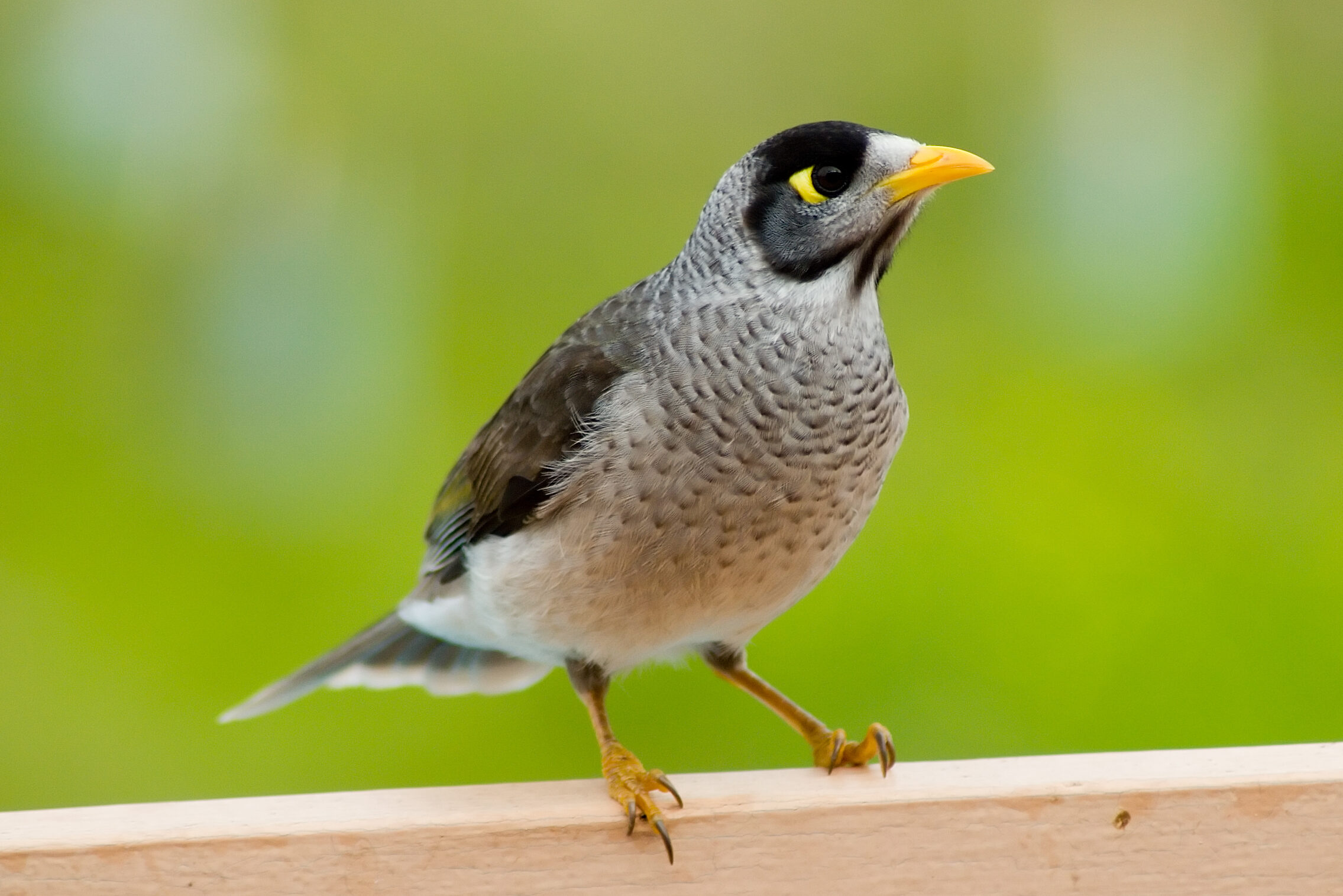
These small birds are feisty, and they certainly live up to their ‘noisy’ moniker. Grey-feathered with a black face and a yellow bill, noisy miners can be found in suburban gardens and parks. As part of the honeyeater family, they eat nectar, fruit and insects, usually in a rowdy group.
Noisy miners are aggressive, often attacking much bigger birds such as hawks. They’re also curious: some have been recorded opening sugar packets at cafés in search of a sweet snack.
Don’t confuse noisy miners, which are native, with the introduced common myna. Noisy miners are mostly grey whereas common mynas are dark brown and black.
Size: 26cm
Call: Loud piping ‘pee-pee-pee’.
Where to spot them: Woodland, urban parks and gardens.
Laughing kookaburra
Dacelo novaeguineae
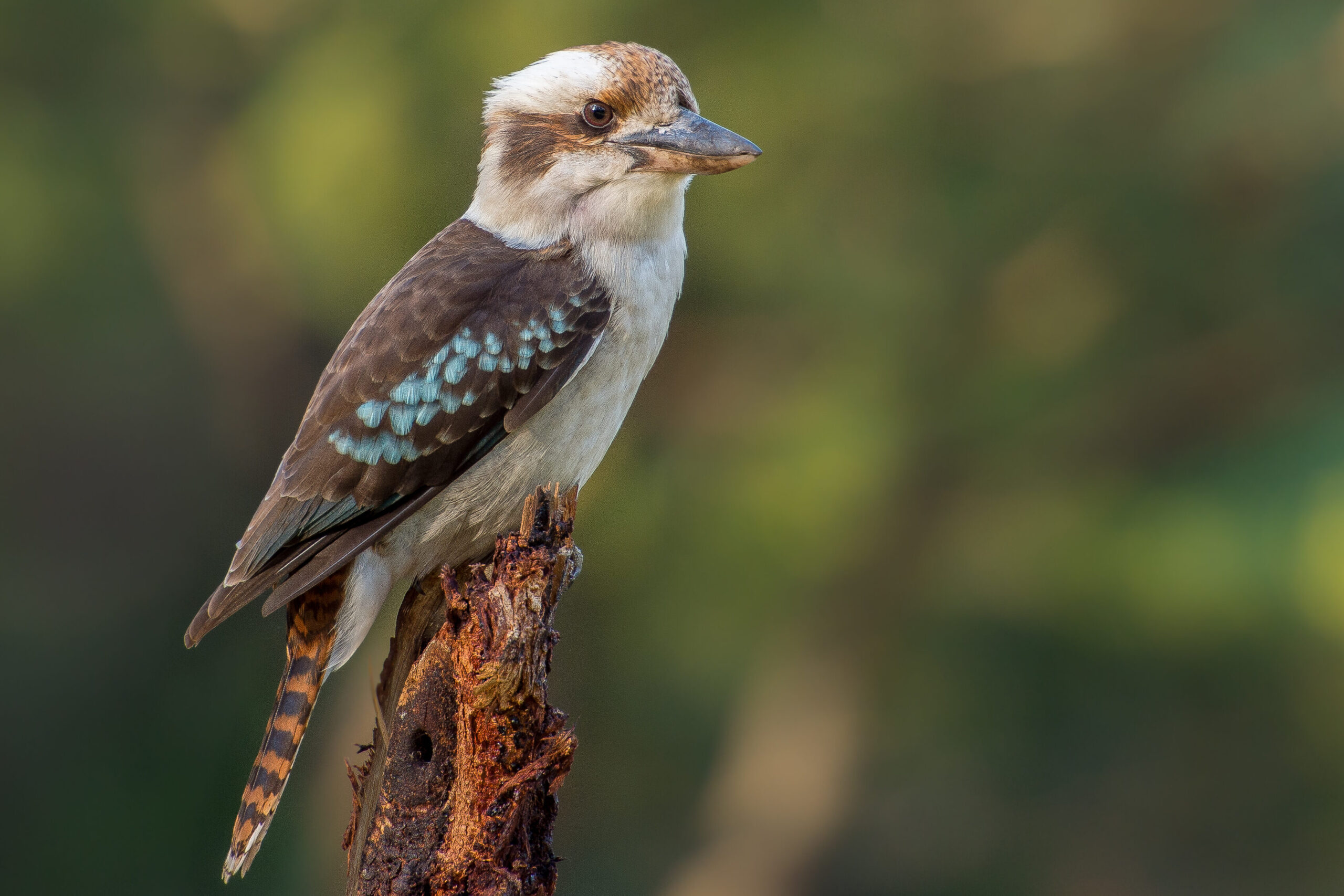
The chuckling crescendo call of the kookaburra is unmistakable. But no, Kooky’s not laughing at you – he’s actually telling other birds to stay out of his territory.
The laughing kookaburra is the bird emblem of NSW, and its name is a loanword from the Wiradjuri language. These birds have a white chest and face, brown back and wings, a prominent brown eye-stripe, and stripes on their tail feathers.
Kookaburras are one of the largest kingfisher species in the world. They eat insects, fish and crustaceans – swallowed whole – while bigger meals, such as birds, frogs and small mammals, are tenderised by bashing against a hard surface before being eaten.
Size: 42cm
Call: Laughing ‘koo koo kaa kaa’ that increases in volume and speed.
Where to spot them: sitting on power lines, fences and in trees.
Australian magpie
Cracticus tibicen

A fixture of playing fields and early morning soundscapes across Australia, magpies are one of the most conspicuous birds you’re likely to spot in Sydney. A medium-sized bird, they have black and white plumage with a sharp beak.
However, the exact colouring pattern varies across their range. Birds in Sydney have a black back and less white than their Victorian counterparts. Males have pure white feathers and females’ feathers are white-grey ombré. Juveniles are have fluffy down feathers, more grey colouring, and can usually be seen begging for food.
Magpies hang out in groups of up to 24, and they will collectively defend their territory against other ‘pies. Although they are pretty tame for most of the year, spring (breeding season) is accompanied by a fierce aggressiveness. Some birds will defend their nesting territory in a swoop of feathered black and white fury, bringing terror to unsuspecting walkers and cyclists.
Size: 40cm
Call: Loud flute-like song. The ‘quardle-oodle-ardle-wardle-doodle’ call is one of the most complex vocalisations in the bird world.
Where to spot them: Suburban gardens, parks, sports fields and farms paddocks.
Australian raven
Corvus coronoides
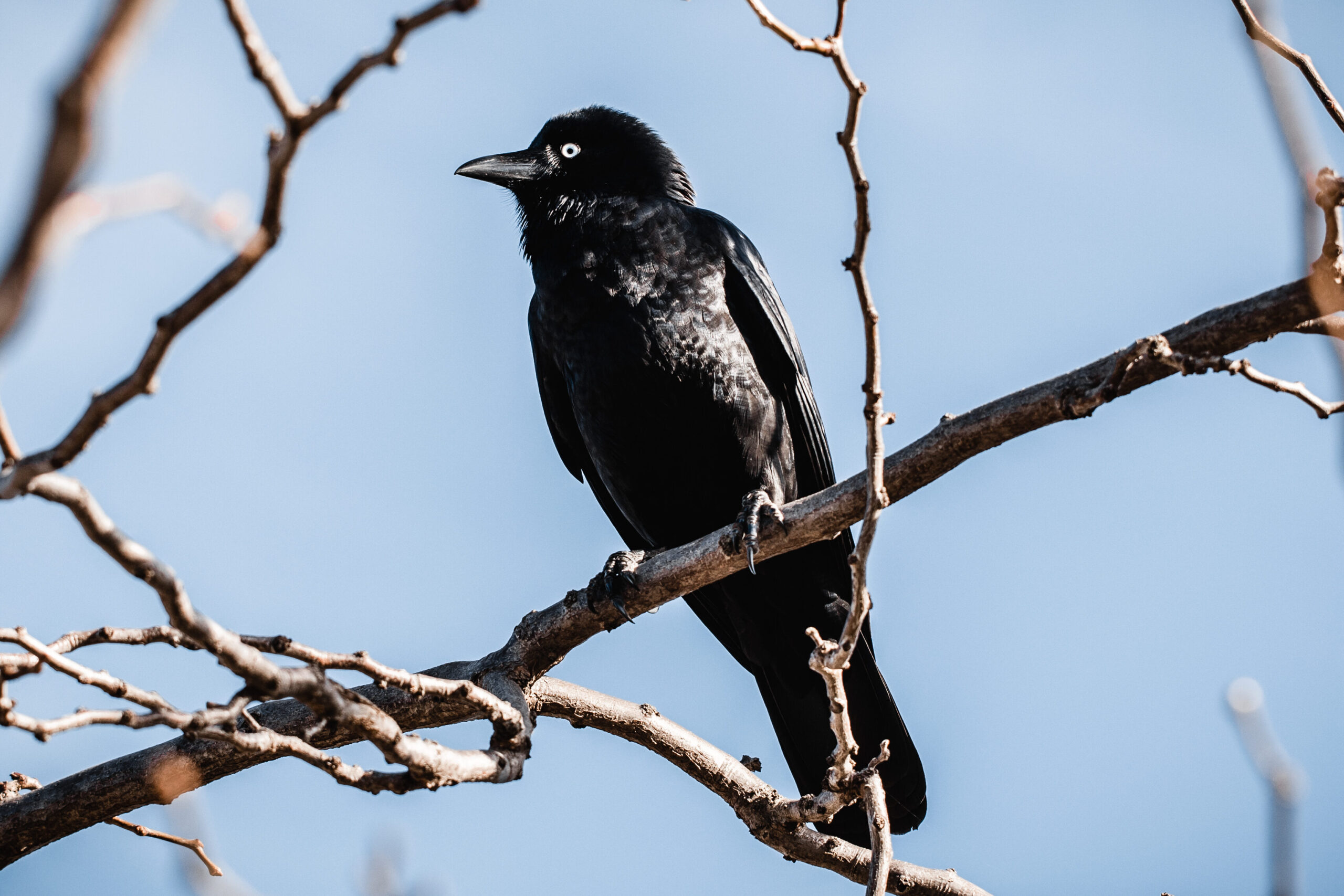
Dressed in black from beak-to-claw, ravens have a glossy sheen and striking white eyes. They can be distinguished from crows and other raven species by their long neck-beard feathers called ‘hackles’, which they extend when they call. The Australian raven is more common than other crows and ravens in Sydney.
Ravens have adapted to a range of habitats, including urban settings where they scavenge scraps. They are intelligent – like all corvids – especially when it comes to finding food.
Size: 50cm, up to 1m wingspan
Call: Listen out for their cawing ‘aah-aah-aaaaahhhh’.
Where to spot them: Parks, around bins, farmland.
Pied currawong
Strepera graculina
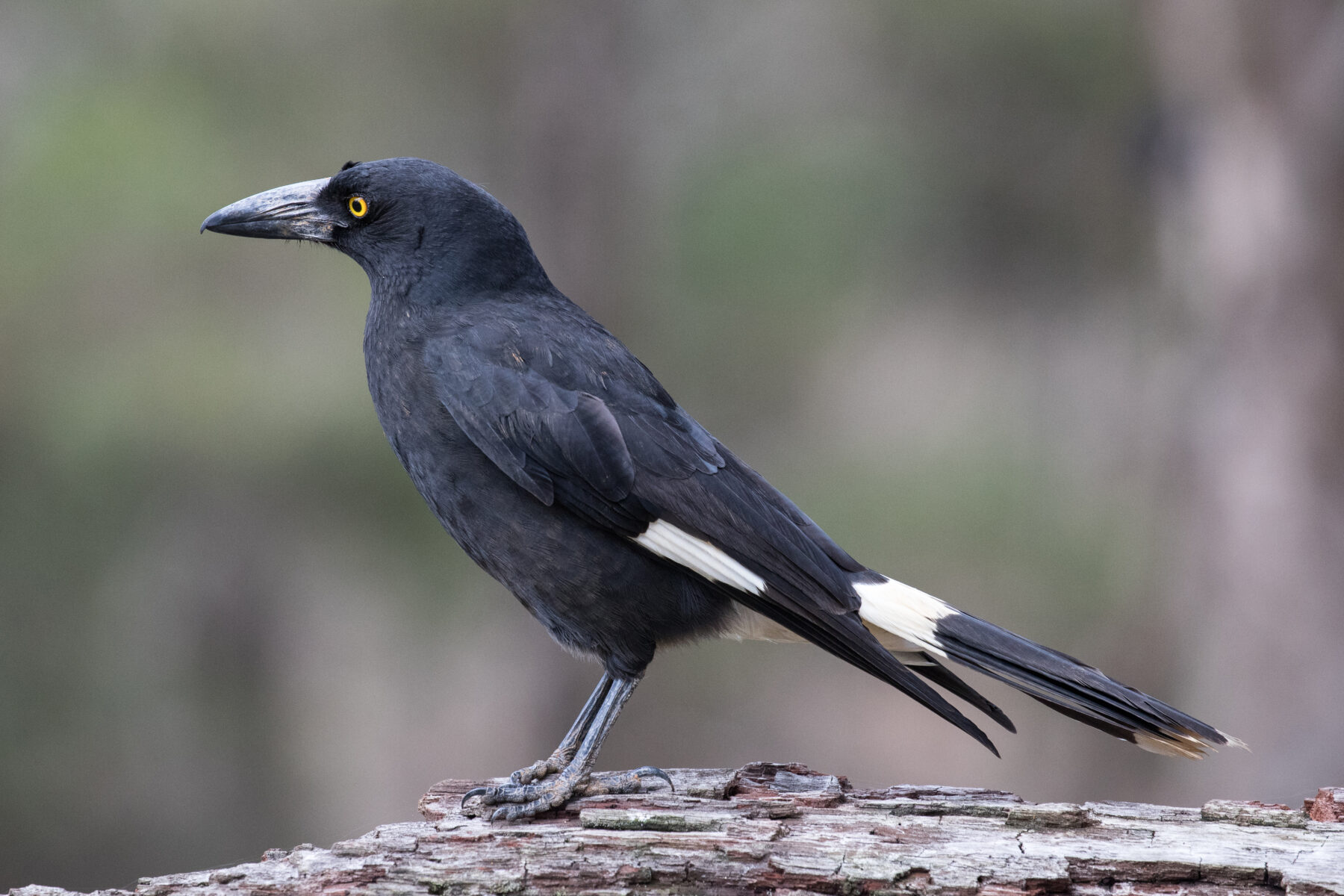
Pied currawongs differ from other currawongs thanks to their splashes of white; they’re mostly black with a little white on their tails and wingtips. These birds may superficially resemble magpies, but they have much less white in their plumage, and they have yellow eyes. They are also slightly bigger than magpies.
Pied currawongs have found a cosy life in the suburbs. They eat everything from plums to possums, sometimes hiding their food for later. In the city, pied currawongs have proliferated as they feed on small birds – prey that is rendered more vulnerable in urban areas due to lack of protective cover.
Size: 48cm
Call: Distinctive ‘currawong’, sometimes croaks.
Where to spot them: Woodland, treed suburbs.
